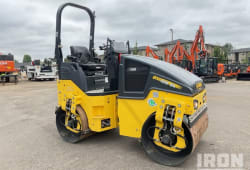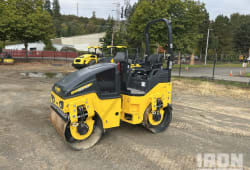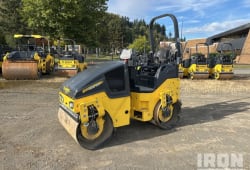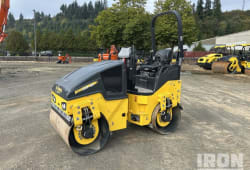Ground Control: Tips How Vibratory Plate Compactors Form Surfaces
9 Min read
)
January 20, 2024
In the world of construction and earthwork, achieving a solid, stable foundation is paramount. This is where vibratory plate compactors come into play. These powerful machines are the unsung heroes of the construction site, tirelessly working to compress and settle various materials, ensuring a level and stable surface for structures and pavements. In this comprehensive exploration, we will delve into the inner workings and significance of vibratory plate compactors. From their fundamental principles to their diverse applications, we will uncover how these compact machines have revolutionized the art of ground control, making them indispensable tools in the construction industry.
Understanding Vibratory Plate Compactors
:format(webp))
Vibratory plate compactors are essential tools in construction and soil stabilization due to their unique principles of operation. At their heart, these machines consist of a compact and easily maneuverable design, featuring a heavy vibrating plate. This plate serves as the workhorse, applying downward force to the surface it rests upon.
The key to their effectiveness lies in the rapid vibrations generated by the plate. As the machine is activated, these vibrations are transmitted into the material beneath, penetrating it deeply. This dynamic compaction action accomplishes several critical tasks simultaneously. Firstly, it efficiently eliminates air voids within the material, effectively reducing the spaces between particles.
Secondly, it compacts the material in a uniform and controlled manner, enhancing its density and shear strength. As a result, the soil or other material becomes more stable, with improved load-bearing capacity. By settling the material and minimizing voids, vibratory plate compactors play an integral role in creating solid and stable foundations for construction, roadways, and various structures.
Principles of Compaction
The principles of compaction are fundamental to the effectiveness of vibratory plate compactors and their role in construction and soil stabilization. At the core of these principles lies the concept of densification and the reduction of void spaces within the material being compacted. When a vibratory plate compactor is applied to the surface, it generates rapid vibrations that penetrate the material. These vibrations cause the particles within the material to move closer together, reducing the voids between them.
As a result, the soil or other material becomes more tightly packed, increasing its density and shear strength. This densification process serves several critical purposes. First, it enhances the load-bearing capacity of the material, making it better suited for supporting structures or roadways. Second, it reduces settlement over time, ensuring the stability and longevity of the compacted surface. Finally, it improves the material's resistance to water infiltration, preventing moisture-related issues like erosion and subsidence.
Applications in Construction
In construction, vibratory plate compactors are indispensable tools for preparing foundations and surfaces. They excel in compacting a wide range of materials, including granular soils, crushed aggregate, asphalt, and paving stones. Their rapid vibrations effectively eliminate air voids and settle materials, ensuring uniform and stable surfaces. By enhancing soil density and shear strength, these compactors minimize the risk of settlement or structural damage, making them essential for creating solid foundations for buildings, roadways, and various structures. Their efficiency and versatility contribute significantly to the success and durability of construction projects.
Landscaping and Ground Preparation
In landscaping and ground preparation, vibratory plate compactors play a pivotal role. These versatile machines are used to create stable and even surfaces for a variety of outdoor projects. From gardens and patios to walkways and driveways, they efficiently compact soil, gravel, and sand, ensuring a solid foundation. By eliminating air voids and settling materials, vibratory plate compactors help prevent subsidence, enhance load-bearing capacity, and promote the longevity of outdoor structures. Their manoeuvrability and ease of use make them indispensable tools for achieving a well-prepared canvas for landscaping and outdoor improvements.
Maintenance and Safety
Proper maintenance and safety precautions are essential when working with vibratory plate compactors. Regular maintenance ensures optimal performance and longevity, while adhering to safety guidelines and prevents accidents and injuries on the job site:
Maintenance
Regular Inspections: Routine inspections of the plate compactor should be conducted before each use. This includes checking for loose bolts, damaged components, and worn-out parts. Any issues should be promptly addressed to prevent further damage.
Lubrication: Proper lubrication of moving parts, such as the plate's bearings and engine components, is essential. Lubrication not only reduces wear but also ensures smooth operation.
Engine Maintenance: Regular servicing of the engine, including oil changes and spark plug replacements, is crucial. Proper engine maintenance ensures reliable operation and minimizes breakdowns.
Safety
Protective Gear: Operators should wear appropriate personal protective equipment (PPE), including hearing protection, eye protection, and steel-toed boots. High-visibility clothing is also advisable to enhance visibility on the job site.
Clear Communication: Effective communication among team members is crucial. Operators should have clear signals with spotters and other workers to prevent accidents or injuries.
Safe Operation: Vibratory plate compactors should only be operated on stable ground and within their specified load and slope limits. Avoid operating the equipment on steep inclines, unstable terrain, or near edges.
Challenges and Limitations
Vibratory plate compactors are indeed valuable tools for ground control, but they are not without their challenges and limitations. Recognizing and addressing these limitations is essential for achieving successful compaction projects
Soil Type Dependency: One significant limitation is their varying effectiveness across different soil types. While vibratory plate compactors excel at compacting granular soils, they may struggle with cohesive or saturated soils. Clayey soils, for instance, can be challenging due to their high moisture content and cohesive nature, making compaction less efficient.
Depth Limitations: Vibratory plate compactors are most effective for shallow compaction depths. Deeper compaction often requires larger, heavier machinery, like smooth drum rollers or padfoot rollers. Attempting deep compaction with a plate compactor can be time-consuming and may yield inadequate results.
Skilled Operation: Operating a vibratory plate compactor effectively requires skill and experience. Proper technique, including maintaining consistent speed and overlapping passes, is crucial to achieving uniform compaction. Inadequate operator training can lead to uneven compaction and the risk of over-compaction, which can be detrimental to the soil's structural integrity.
Limited Maneuverability: Plate compactors may have limitations in tight or confined spaces, limiting their manoeuvrability. This can make it challenging to access certain areas of a construction site, requiring alternative compaction methods.
Noise and Vibration: Vibratory plate compactors generate noise and vibration during operation, which can be a concern in noise-sensitive environments or urban areas. Noise reduction measures or alternative compaction methods may be necessary to mitigate these issues.
Weight and Force Limitations: Plate compactors come in various sizes and weights, and their compaction force is limited compared to heavier machinery. Therefore, they may not be suitable for larger or heavy-duty projects where greater compaction forces are required.
Innovations and Future Trends
The vibratory plate compactor industry has experienced a significant transformation, driven by continuous innovations and evolving trends. These advancements are reshaping the future of ground control in construction and earthwork projects.
Advanced Materials: Manufacturers are exploring the use of advanced materials, such as lightweight alloys and reinforced composites, in the construction of plate compactors. These materials enhance durability while reducing the overall machine weight, making them more manoeuvrable and efficient.
Ergonomic Designs: Future plate compactors are expected to feature ergonomic designs, improving operator comfort and reducing fatigue during prolonged use. Adjustable handles, vibration-dampening systems, and intuitive controls will enhance the user experience.
Smart Technology: Integration of smart technology is on the horizon. These compactors may feature sensors and onboard computers that monitor compaction progress, soil density, and machine performance in real time. Data can be transmitted to project managers for analysis and decision-making.
Fuel Efficiency: In response to environmental concerns, manufacturers are working on enhancing fuel efficiency in gasoline and diesel-powered models. This not only reduces emissions but also lowers operating costs.
Electric and Hybrid Options: As sustainability gains prominence, electric and hybrid vibratory plate compactors are emerging. These eco-friendly alternatives are quieter, produce zero emissions, and are suitable for both indoor and outdoor applications.
Telematics and Remote Control: Remote monitoring and control capabilities are being integrated. Operators can remotely adjust settings, track compaction progress, and receive maintenance alerts, improving efficiency and reducing downtime.
Hybrid Vibrations: Innovations in vibration mechanisms are being explored. Hybrid vibration systems that combine high-frequency and high-amplitude vibrations are being developed for improved compaction efficiency in various soil types.
Automation: Automation and autonomous operation are potential future trends.
The future of vibratory plate compactors is characterized by enhanced efficiency, sustainability, operator comfort, and advanced technology integration. These innovations are not only revolutionizing ground control but also aligning with the construction industry's growing emphasis on safety, environmental responsibility, and productivity.
Conclusion
Vibratory plate compactors stand as silent champions of construction and ground control. Their ability to transform loose or uneven surfaces into solid foundations is the bedrock of countless infrastructure projects. As we delve into the world of vibratory plate compactors, we gain a deeper appreciation for their significance in shaping stable, safe, and long-lasting surfaces. These machines have not only revolutionized the construction industry but have also paved the way for a more reliable and resilient built environment.

Rex Walz is Boom & Bucket's Manager of Supplier Relations, bringing over a decade of experience in B2B sales and heavy equipment solutions. With a background spanning government, construction, industrial, and commercial sectors, he has a proven track record of driving growth and building trusted customer relationships. At Boom & Bucket, Rex is passionate about helping partners succeed while advancing the company's mission to create the most trusted marketplace for heavy equipment.














